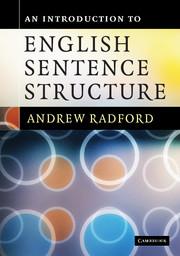7 - Agreement, case and A-movement
Summary
Overview
In this chapter, we take a look at the syntax of agreement. We begin by outlining the claim made by Chomsky in recent work that agreement involves a relation between a probe and a goal (though it should be noted that the term goal in this chapter is used in an entirely different way from the term goal – written in capital letters – which was used to denote the thematic role played by a particular kind of argument in relation to its predicate in §6.4). We look at the nature of agreement (exploring its relation with case-marking on the one hand, and with movement on the other) and examine the consequences of this for control infinitives on the one hand and raising infinitives on the other.
Agreement
In traditional grammars, finite auxiliaries are said to agree with their subjects. Since (within the framework used here) finite auxiliaries occupy the head T position of TP and their subjects are in spec-T, in earlier work agreement was said to involve a specifier–head relationship (between T and its specifier). However, there are both theoretical and empirical reasons for doubting that agreement involves a spec–head relation. From a theoretical perspective, Minimalist considerations lead us to the conclusion that we should restrict the range of syntactic relations used in linguistic description, perhaps limiting them to the relation c-command.
- Type
- Chapter
- Information
- An Introduction to English Sentence Structure , pp. 237 - 278Publisher: Cambridge University PressPrint publication year: 2009



